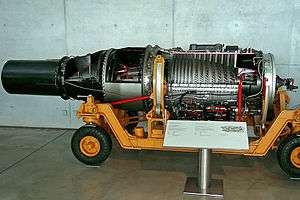Wright J65
| J65 | |
|---|---|
 | |
| Sectioned Wright J65 | |
| Type | Turbojet |
| Manufacturer | Curtiss-Wright |
| First run | 1 October 1948 |
| Major applications | Douglas A-4 Skyhawk Grumman F-11 Tiger Martin B-57 Canberra Republic F-84F Thunderstreak |
| Developed from | Armstrong Siddeley Sapphire |
The Wright J65 was an axial-flow turbojet engine produced by Curtiss-Wright under license from Armstrong Siddeley. A development of the Sapphire, the J65 powered a number of US designs.
Design and development
Curtiss-Wright purchased a license for the Sapphire in 1950, with plans to have the production lines running in 1951. However a series of delays due to design changes by Curtiss-Wright, such as substituting the Sapphire's machined midsection solid forged diffuser frame with a fabricated one of welded nodular iron,[1] led to its service introduction slipping two years. The fabricated assembly, a more practicable production job at about one fifth the cost was subsequently adopted for the Sapphire.[2] Another design change which was also evaluated for the Sapphire, but not adopted, addressed compressor blade stalling (and subsequent fatigue) at low engine RPM. Ramps were installed at the entry to the compressor. They were raised at low RPM to prevent stalling.[3][4]
By service introduction the Pratt & Whitney J57 was on the market and took many of the J65's potential sales. Nevertheless, along with the Martin B-57 Canberra, its original application, the J65 went on to power versions of the North American FJ Fury, Douglas A-4 Skyhawk, Republic F-84F Thunderstreak, and the two Lockheed XF-104 Starfighter prototypes. Problems Grumman had with the engine in the F11F Tiger, particularly below-spec after-burning thrust, caused them to specify the J79 for the Grumman F11F-1F Super Tiger.[5]
Wright T49
A 6,500–10,380 shp (4,850–7,740 kW) turboprop version of the J65 (Sapphire) was developed by Curtiss-Wright as the Wright T49, and a commercial derivative, the Wright TP51A2 was also designed. The T49 first ran in December 1952 at 8,000 shp (6,000 kW), followed by flight testing in a Boeing XB-47D test bed from 26 August 1955. By this time however, the market for the engine had vanished.[6]
Applications
- Douglas A-4 Skyhawk
- Grumman F-11 Tiger
- Martin B-57 Canberra
- Lockheed XF-104
- North American FJ-3 Fury
- North American FJ-4 Fury
- Republic F-84F Thunderstreak
- Boeing XB-47D (T49 testbed)
Specifications (J65-B)
General characteristics
- Type: Turbojet
- Length: ~122in (~3098 mm)
- Diameter: 37.52in (953 mm)
- Dry weight: 2776lb (1259 kg)
Components
- Compressor: 13-stage axial
- Combustors: annular
- Turbine: 2-stage axial
Performance
- Maximum thrust: 7,239lbf (32.2KN)
- Overall pressure ratio: 7:1
- Air mass flow: 119.05lb/s (54kg/s)
- Turbine inlet temperature: ~848C (1558F)
- Specific fuel consumption: ~0.916 lb/(lbf·h) (25.9 g/(kN·s))
- Thrust-to-weight ratio: 2.61
See also
- Related development
- Comparable engines
- Related lists
References
- ↑ "World Encyclopedia of Aero Engines - 5th edition" by Bill Gunston, Sutton Publishing, 2006, p.249
- ↑ https://www.flightglobal.com/pdfarchive/view/1956/1956%20-%200020.html
- ↑ https://www.flightglobal.com/pdfarchive/view/1956/1956%20-%200022.html
- ↑ ntrs.nasa.gov/archive/nasa/casi.ntrs.nasa.gov/19930088525.pdf
- ↑ "Grumman's Mach-2 International F11F-1F Supertiger" Corwin Meyer, Naval Fighters Number Forty-Four, Steve Ginter 1998, ISBN 0-942612-44-2, p.1
- ↑ "World Encyclopedia of Aero Engines - 5th edition" by Bill Gunston, Sutton Publishing, 2006, p.249
- Gunston, Bill (2006). World Encyclopedia of Aero Engines, 5th Edition. Phoenix Mill, Gloucestershire, England, UK: Sutton Publishing Limited. ISBN 0-7509-4479-X.
- Kay, Anthony L. (2007). Turbojet History and Development 1930-1960. 2 (1st ed.). Ramsbury: The Crowood Press. ISBN 978-1861269393.
External links
| Wikimedia Commons has media related to Wright J65. |
- A 1952 advert for the Sapphire/J 65
- "Anglo-American Jewel - Engineering Details of the Wright J65 Sapphire Revealed" - a 1954 Flight article on the J65